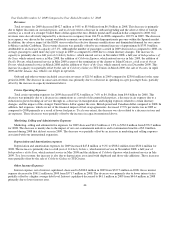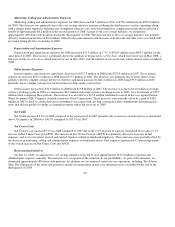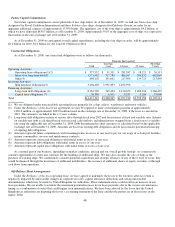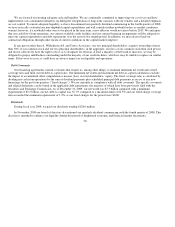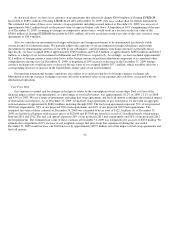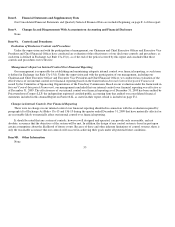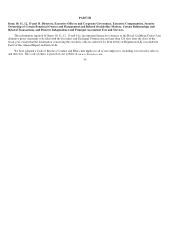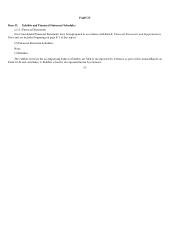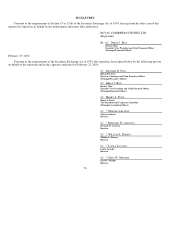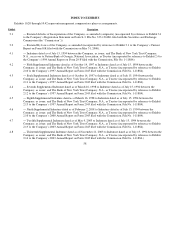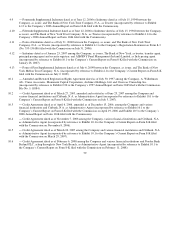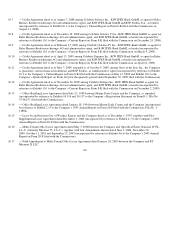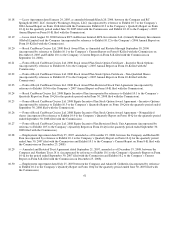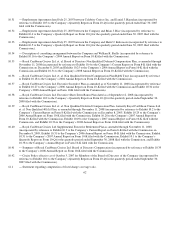Royal Caribbean Cruise Lines 2009 Annual Report Download - page 62
Download and view the complete annual report
Please find page 62 of the 2009 Royal Caribbean Cruise Lines annual report below. You can navigate through the pages in the report by either clicking on the pages listed below, or by using the keyword search tool below to find specific information within the annual report.
As discussed above, we have cross currency swap agreements that effectively change €€300.0 million of floating EURIBOR-
based debt to $389.1 million of floating LIBOR-based debt at December 31, 2009. (See Interest Rate Risk for further information).
The estimated fair value of these cross currency swap agreements including accrued interest at December 31, 2009, was an asset of
approximately $46.1 million based on the present value of expected future cash flows. A hypothetical 10% strengthening of the euro
as of December 31, 2009, assuming no changes in comparative interest rates, would result in a decrease in the fair value of the
€
€300.0 million of floating EURIBOR-based debt by $30.1 million, offset by an increase in the fair value of the cross currency swap
agreements of $30.4 million.
Also, we consider our investments in foreign subsidiaries and foreign investments to be denominated in relatively stable
currencies and of a long-term nature. We partially address the exposure of our investments in foreign subsidiaries and foreign
investments by denominating a portion of our debt in our subsidiaries’ and investments’ functional currencies (generally euros).
Specifically, we have assigned debt of approximately €€346.8 million and €€142.9 million, or approximately $496.8 million and $204.7
million, as a hedge of our net investment in Pullmantur and TUI Cruises, respectively. Accordingly, we have included approximately
$2.5 million of foreign-currency transaction losses in the foreign currency translation adjustment component of accumulated other
comprehensive income (loss) at December 31, 2009. A hypothetical 10% increase or decrease in the December 31, 2009 foreign
currency exchange rate would increase or decrease the fair value of our assigned debt by $57.1 million, which would be offset by a
corresponding decrease or increase in the United States dollar value of our net investment.
Our growing international business operations also subject us to an increasing level of foreign currency exchange risk.
Movements in foreign currency exchange rates may affect the translated value of our earnings and cash flows associated with our
international operations.
Fuel Price Risk
Our exposure to market risk for changes in fuel prices relates to the consumption of fuel on our ships. Fuel cost (net of the
financial impact of fuel swap agreements), as a percentage of our total revenues, was approximately 10.2% in 2009, 11.1% in 2008
and 8.9% in 2007. We use a range of instruments including fuel swap agreements and fuel call options to mitigate the financial impact
of fluctuations in fuel prices. As of December 31, 2009, we had fuel swap agreements to pay fixed prices for fuel with an aggregate
notional amount of approximately $680.4 million, maturing through 2012. The fuel swap agreements represent 51% of our projected
2010 fuel requirements, 50% of our projected 2011 fuel requirements and 10% of our projected 2012 fuel requirements. The
estimated fair value of these contracts at December 31, 2009 was estimated to be an asset of $122.1 million. As of December 31,
2009, we had fuel call options with exercise prices of $120.00 and $150.00 per barrel for a total of 2.8 million barrels which mature
between 2011 and 2012. The fuel call options represent 20% of our projected 2011 fuel requirements and 10% of our projected 2012
fuel requirements. The estimated fair value of these contracts at December 31, 2009 was estimated to be an asset of $10.0 million. We
estimate that a hypothetical 10% increase in our weighted-average fuel price from that experienced during the year ended
December 31, 2009 would increase our 2010 fuel cost by approximately $29.9 million, net of the impact of fuel swap agreements and
fuel call options.
52




